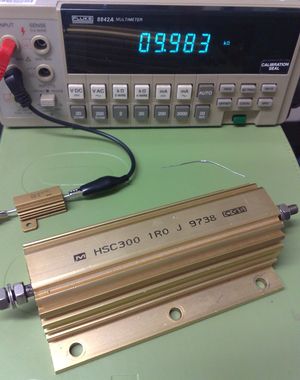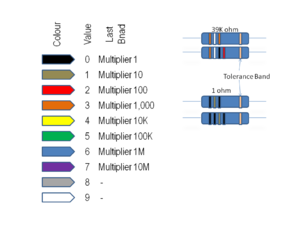Resistor: Difference between revisions
No edit summary |
No edit summary |
||
| Line 8: | Line 8: | ||
== Units of Measurement == | == Units of Measurement == | ||
The modern day unit of measurement is the 'Ohm'. This unit was assigned in 1872. The | The modern day unit of measurement is the 'Ohm'. This unit was assigned in 1872. The measurement standards for the Ohm reference has improved over time, and these standards are maintained by NIST / NATA standards laboratories in temperature controlled environments. | ||
Given the wide range of resistance values and | Given the wide range of resistance values and related measurements, the value of resistance is often prefixed with the the greek multiplier terms, eg. nano-ohm, kilo-ohm, meg-ohm. Resistors are also specified with a power handling capacity, in watts, eg. half-watt, 50 watt, 10kilo-watt etc. | ||
The iunit of measurement for the nverse of Ohm (ie 1/R) is known a Siemens, often used in very low value resistance measurements. | The iunit of measurement for the nverse of Ohm (ie 1/R) is known a Siemens, often used in very low value resistance measurements. | ||
Revision as of 23:12, 18 April 2009
The Resistor
The resistor is a fundamental electrical component in physical circuits as well as circuit analysis and equivalent circuits. All materials exhibit some form of resistance, some are greater than others, eg. copper, aluminium and gold are considered good conductors (low resistance), stainless steel, carbon, tungsten are average conductors (medium resistance), and then ceramics, mica and air are considered poor conductors (high resistance).
Units of Measurement
The modern day unit of measurement is the 'Ohm'. This unit was assigned in 1872. The measurement standards for the Ohm reference has improved over time, and these standards are maintained by NIST / NATA standards laboratories in temperature controlled environments.
Given the wide range of resistance values and related measurements, the value of resistance is often prefixed with the the greek multiplier terms, eg. nano-ohm, kilo-ohm, meg-ohm. Resistors are also specified with a power handling capacity, in watts, eg. half-watt, 50 watt, 10kilo-watt etc.
The iunit of measurement for the nverse of Ohm (ie 1/R) is known a Siemens, often used in very low value resistance measurements.
Color Coding
Traditional wire leaded resistors are typically colour coded to show their resistance value and manufactured tolerance. There are 3 or possibly 4 colour coding band, with examples of their values shown in the diagram in the right. The power ratings are not generally specified on the device, but is usually a function of the physical size of the resistor.

